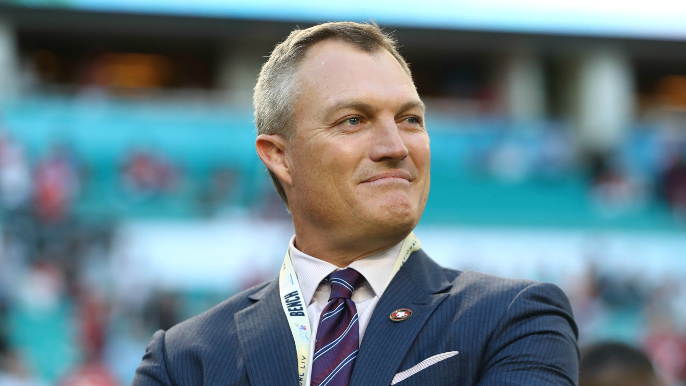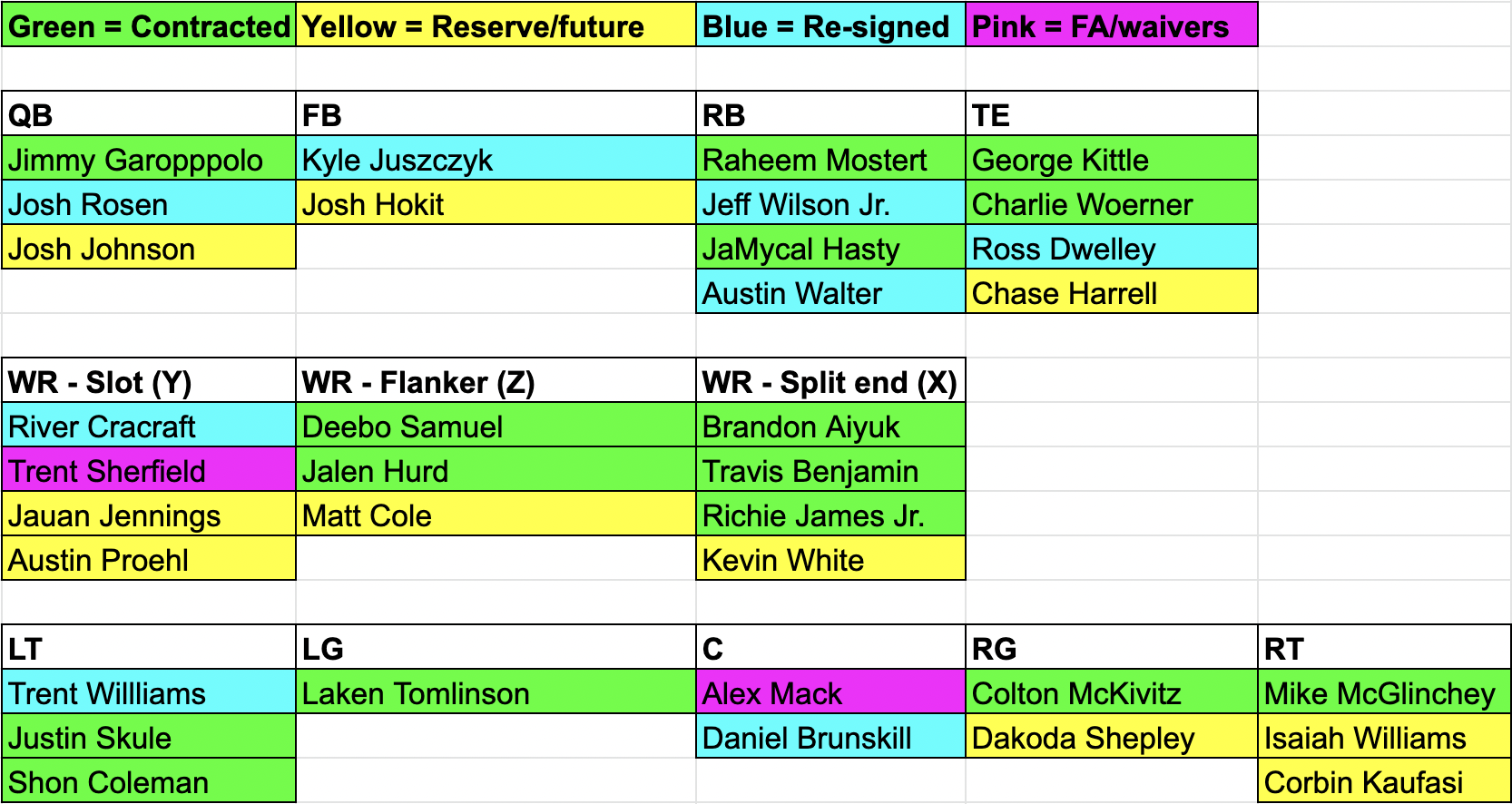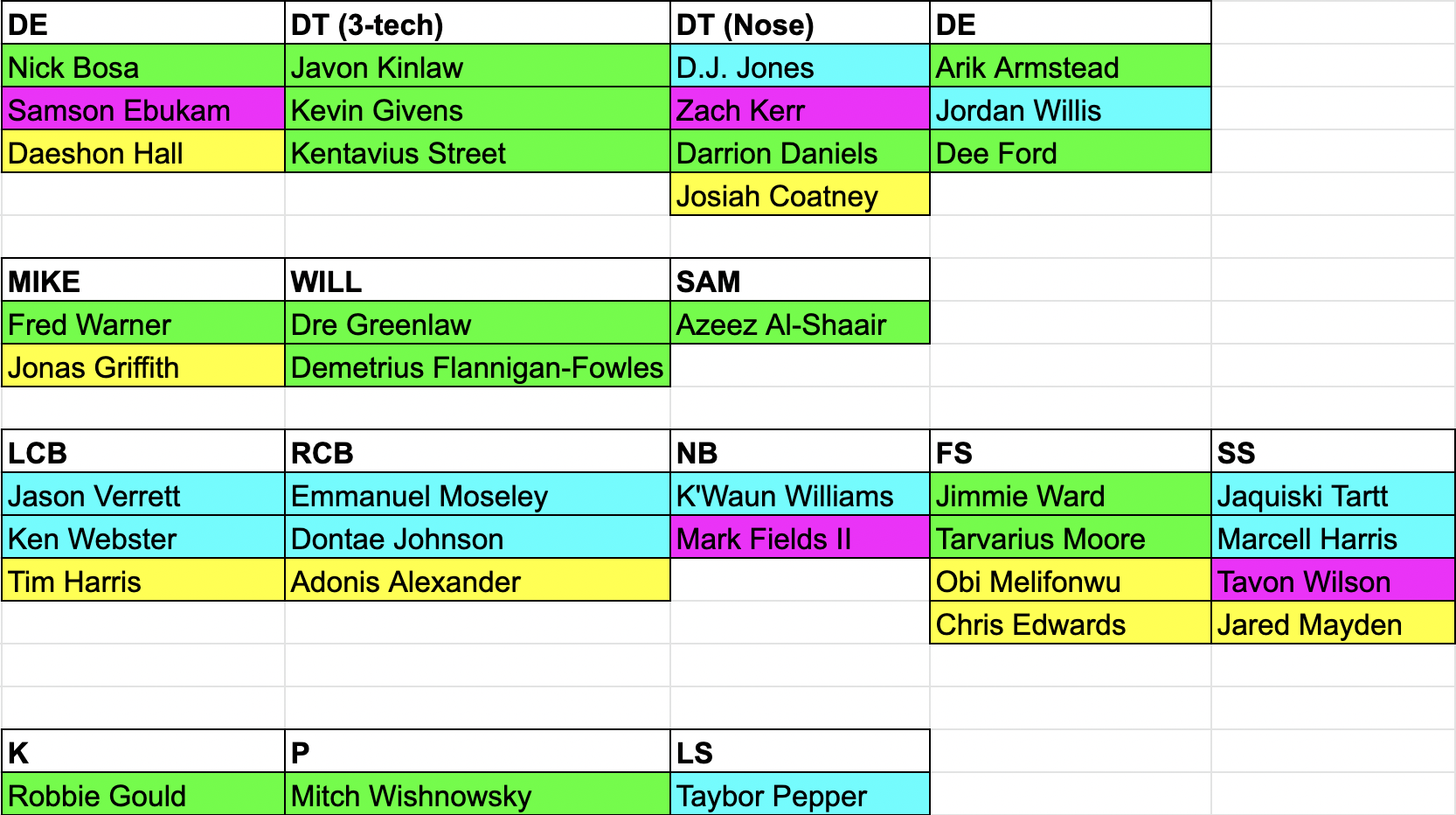© Mark J. Rebilas-USA TODAY Sports
We can safely say the 49ers exceeded expectations for their offseason, even before the draft arrives. That doesn’t excuse potentially terrible draft moves, but it reflects that they are just about free to do what they please in the draft because their needs, aside from two key positions, are filled.
There were four ways in which the 49ers maneuvered or were helped around the limitations of a salary cap which dropped by $16 million, and which normally increases by about $10 million:
- Adjustments/carryover: San Francisco retained roughly $1.9 million in cap space which went unused last season, and more than $11 million from adjustments. That $11 million effectively came from likely-to-be-earned contract incentives from the prior season which were not conveyed, in large part due to injuries and performance. In total, $13.2 million came here, and that opened the floodgates.
- Weston Richburg restructure/retirement: Richburg was a guaranteed cut, but cutting him outright would only have saved about $4.5 million. By restructuring his deal for a third (!) time (the previous restructures covered here – they’re doozies), with Richburg reportedly set to retire, the 49ers decreased his dead cap hit from $6.97 million to $4.59 million. They saved $6.88 million in this third restructure and pending retirement, and an additional $2.38 million more than if they had left his current deal as it was (a post-June 1 cut was also an option to save more money, but that money wouldn’t be available until after the first major wave of free agency).
- Dee Ford restructure: Ford was a tricky situation. He is clearly not healthy and is doubtful to be at the start of the season, let alone at any point this season, meaning his contract, which had an $11.6 million injury guarantee for this year, wasn’t viable to be cut. What he and the 49ers worked out was a deal which is two years, $24 million, with a voidable third year. Just like Richburg, it was Ford’s third contract restructure, and it saved the 49ers $11.17 million in cap space. Even if the 49ers were able to cut him outright, they would have saved only $5.73 million by cutting him, meaning this move was a net of about $5.44 million in a scenario in which they actually could cut him. Effectively, he and the 49ers moved his guaranteed money around to open up substantial short-term cap space, and closed the window on the deal earlier than before.
- Backloaded contract structures: Just about every contract the 49ers worked out was backloaded. Trent Williams’s annual average value (AAV) is $23.06 million, but he counts for just $8.23 million on the cap this season. Samson Ebukam’s AAV is $6 million, but he counts for $3.75 million. Kyle Juszczyk’s AAV is $5.4 million, but he counts for $2.28 million. Alex Mack’s AAV is $4.93 million, but he counts for $3 million. Emmanuel Moseley’s AAV is $4.69 million but he counts for $2.65 million. You get the idea.
With the first three moves above, the 49ers gained $31.31 million in cap space in addition to the roughly $13 million they entered free agency with, for about $44 million in total cap space.
This is what they’ve done with the roster thus far with that space:
Here’s how they used that money in year one (stars* indicate a new signing), only counts top-51 players who currently count against salary cap:
- Trent Williams: $8.23 million cap hit
- Jason Verrett: $5.312 million cap hit
- *Samson Ebukam: $3.75 million cap hit
- D.J. Jones: $3.47 million cap hit
- *Alex Mack: $3 million cap hit
- Emmanuel Moseley: $2.65 million cap hit
- Kyle Juszczyk: $2.28 million cap hit
- Jeff Wilson Jr. $2.05 million cap hit
- Ross Dwelley: $1.6 million cap hit
- Marcell Harris: $1.2 million cap hit
- *Trent Sherfield: $920k
By my surely flawless calculations, that’s a $29 million outlay for this current season, leaving just about $15 million remaining. All other retentions were at or below the $850k minimum. Numbers we’re still waiting on:
- Jaquiski Tartt
- K’Waun Willliams
- *Zach Kerr
- Jordan Willis
I would expect that those remaining signings take up at least half of that $15 million. Let’s say it’s $4 million for Williams, $4 million for Tartt, $1.5 million for Kerr, $1.2 million for Willis. That’s roughly $10 million, but only a practical cap hit of $7.3 million, leaving about $7.7 million in cap space.
Currently, the 49ers need to budget $2.86 million for their rookie pool, which would leave them with about $5 million in cap space, and maybe just enough room to go after one more non-minimum free agent.
But if they traded up to, let’s say, the fourth overall pick (Atlanta) for this year’s first- and third-round picks along with next year’s first- and fourth-round picks, they’d have to budget $5.71 million for their rookies (only the first- and second-round picks would affect the cap), leaving just $2 million in cap space.
They can find money by extending Laken Tomlinson, who is scheduled to make $6.59 million. That move would save up to $3.68 million.
That creates enough money for the most expensive rookie pool, in a trade up scenario. But operating costs during the season could take them over that mark. At that point you can restructure one or both of Arik Armstead and Jimmie Ward’s contracts for up to about $4 million each.
So, what’s left and what can they actually pull off?
As of right now, I see just two glaring positions of real need, with a number of other positions that either will be bolstered or are expected to be. That’s a starting slot receiver to replace Kendrick Bourne, and a backup quarterback.
Ideally, you’d think the 49ers would like some veteran insurance rather than having to lean on a rookie to take over Bourne’s role. The wide receiver market was arguably the slowest out of the gate, but many of the enticing names have come off the board. Some names in that group stick out: Willie Snead, Demarcus Robinson, Danny Amendola and…. Mohamed Sanu.
I know, you’re probably sick of Sanu after the experiment failed. But he’s almost assuredly available on a one-year, veteran minimum deal, knows Shanahan’s offense and fits the bill. It’s surely a question of health, but bringing him back, at least for camp, as a guy who was immediately well-liked last season, would be good business. The other three are much higher impact from the outset, but may be in an uncomfortable price range.
As for quarterbacks, you’re really looking at a trade or the draft. The only two clear trade options are Sam Darnold (who would come with a $4.77 million cap hit) or Gardner Minshew, who is probably the more appealing option given that he won’t cost a second-round pick like Darnold reportedly will, and his cap hit is just $897k next season, with another year at $1.01 million left in 2022.
That’s a very cost-efficient backup option and a guy who has performed, for the most part, pretty well with Jacksonville. ESPN’s Jeremy Fowler said he thinks the 49ers could be in play for Minshew. He was also coached up by Kyle Shanahan and the 49ers’ staff at the 2019 Senior Bowl, where he reportedly left a good impression.
If it’s not either of those two, you’re looking at the draft, where you will likely have to trade up for one of the top four (or five, depending on how you view Mac Jones), or be looking at the second group of players like Kellen Mond, Jamie Newman, Kyle Trask and Davis Mills. Mills, the soon-to-be Stanford alum, seems like a viable target in Round 3.
After those positions, you’re absolutely going to need to add young depth at corner. I wouldn’t be surprised to see the 49ers take more than one bite of the apple there if they keep their nine picks, but they haven’t shown they’re willing to go after that position in the first round, especially not this early.
My expectation is that the 49ers either take a defensive end in the first round or a quarterback, with corner a distant third. Tight end Kyle Pitts (if he falls) or one of the elite receivers in the draft, like Jaylen Waddle, JaMarr Chase, or even Devonta Smith, are some sneaky options too. A trade down there could also be in play if they see someone like the Patriots desperate to get up and go after a tackle or someone like Jones.
You could probably afford to add an interior offensive lineman and swing on an athletic tight end. And with Fred Warner entering the final year of his contract, it may be worth evaluating whether you can afford to re-sign him and Dre Greenlaw, and take a look at a long-term replacement for one of those two at linebacker.
In reviewing what’s left for the 49ers this offseason, you quickly see that outside of a backup quarterback (or starter of the future), another receiver, a young corner and defensive end, everything else is an absolute luxury. The 49ers are genuinely in position to swing as high and as aggressively on talent, not needs, thanks to the business they’ve already conducted.




